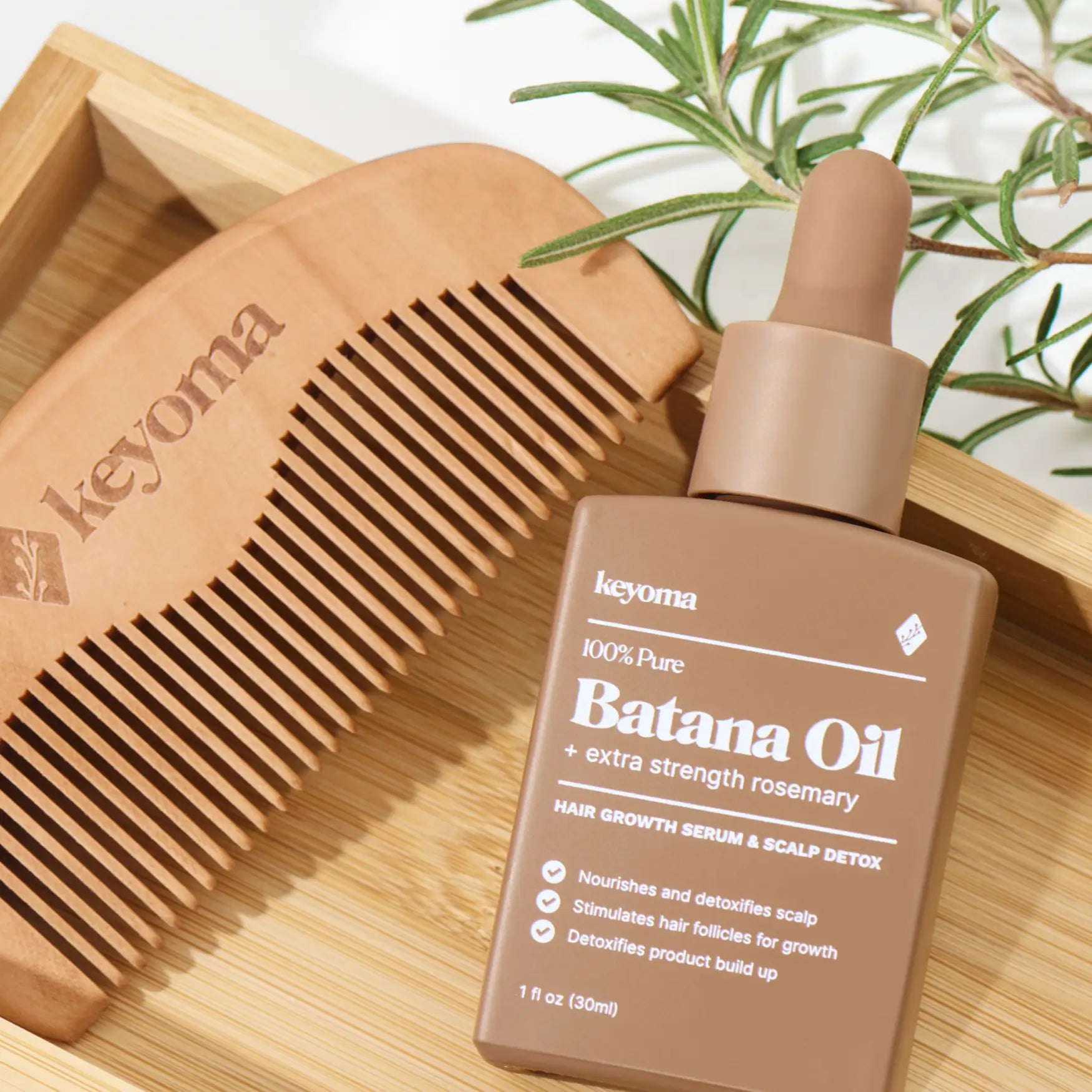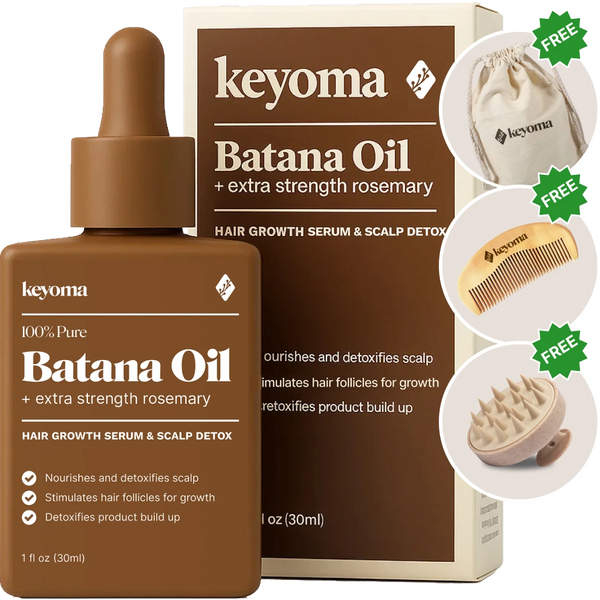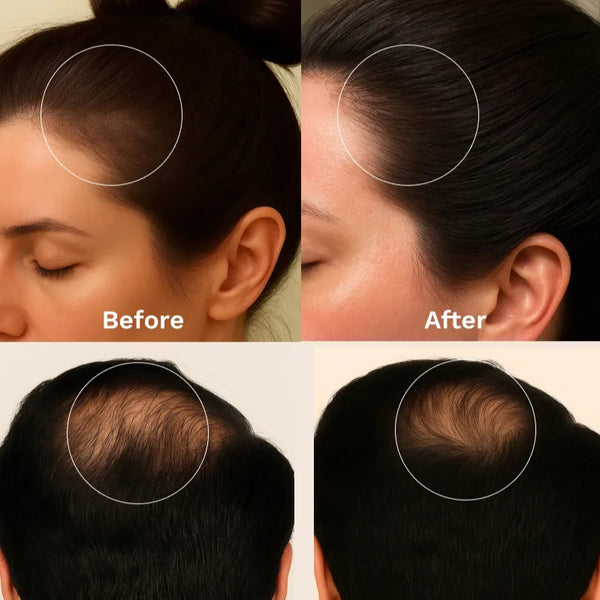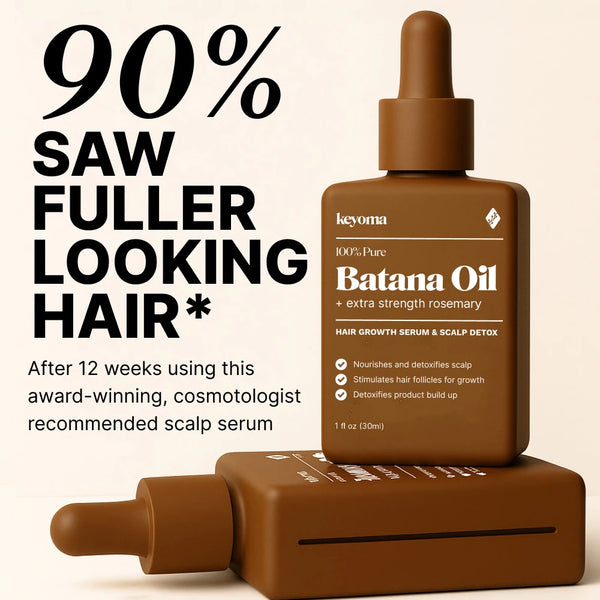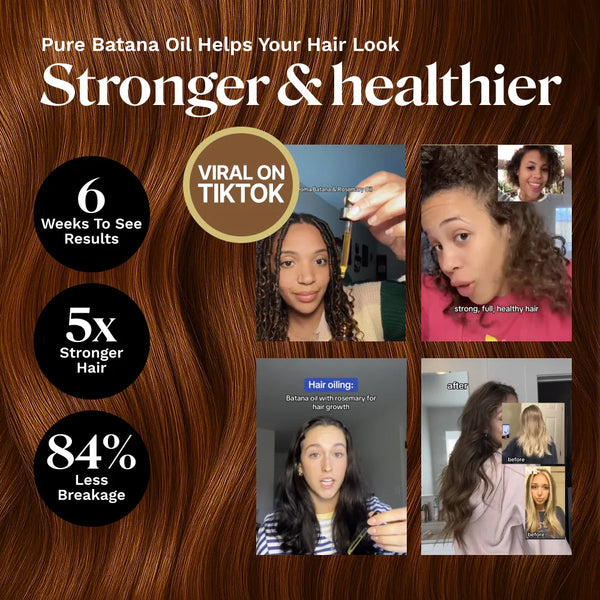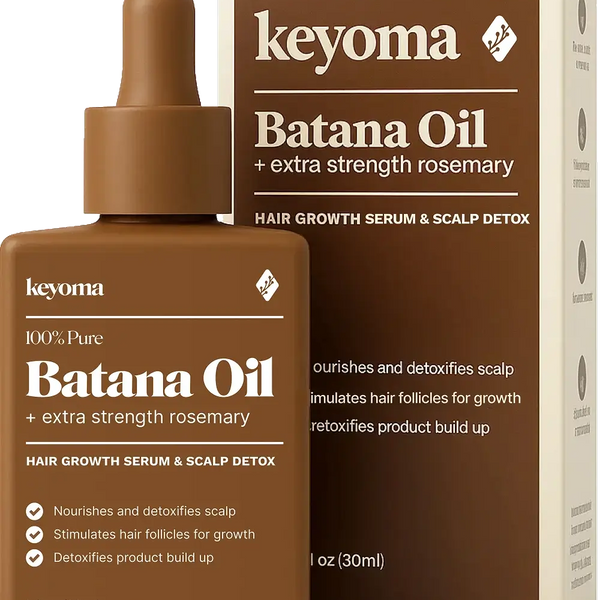In this article
You’re brushing your hair, and there it is again. That stubborn shine that’s more greasy than glossy. You washed it just yesterday, so why does it already look like day three?
Here’s the thing: your scalp’s natural oils, or sebum, actually play an important role. They protect your strands, keep them hydrated, and maintain a healthy scalp barrier. But sometimes, those glands go into overdrive, leaving you with limp, slick roots and that never-fresh feeling.
In this guide, I’ll walk you through why your hair gets oily so fast, the real causes behind it, and the simple changes that actually work to bring your scalp back into balance.
What Makes Hair Oily? Common Causes of Oily Hair
Overwashing
Washing your hair more often might seem like the most intuitive fix for greasy roots, but in reality, it strips away more natural sebum than it should. This, in turn, signals your oil glands to overproduce to compensate, leaving your hair oily again within hours.
How to fix it:
The better approach? Find balance. Most people do well washing every two to three days using a sulfate‑free shampoo for oily hair, which is formulated with ingredients much gentler to the scalp.
Also, remember that water temperature matters. Hot water opens the scalp’s pores and speeds up oil production. Stick to lukewarm and finish with a cool rinse to help seal the cuticle and maintain shine.
Underwashing
Going too long without washing can trigger the same greasy cycle as overwashing, just from the opposite direction.
When sebum, sweat, and dead skin build up on the scalp from underwashing, they mix and form a layer that traps dirt and feeds certain yeast strains like Malassezia, often leading to seborrheic dermatitis, a condition easily mistaken for simple oiliness.
As buildup slowly clogs the pores, it signals the glands to produce even more oil in an attempt to “flush” the debris, which only worsens the problem.
Now, it's worth mentioning that skipping wash days can be beneficial, but only for certain dry hair types. It’s rarely ideal for those with fine or straight hair, where oil travels quickly from root to tip.
How to fix it:
Before adjusting your routine to wash less often, confirm your scalp truly needs cleansing more frequently and not just better technique (like gentler massage or cooler water). If oil remains even right after washing, that’s a clear sign of underwashing.
Gradually increase wash frequency to every other day using a pH‑balanced shampoo (around 5.5) formulated for oily scalps.
Pair it with a lightweight, silicone‑free conditioner applied only to mid‑lengths and ends. That keeps moisture where it’s needed while letting your scalp breathe.
Sulfates
Sulfates are foaming detergents commonly found in shampoos, and while they’re great at removing dirt and oil, they’re often too good at their job. When used regularly, especially on naturally oily scalps, not only do they strip away grease but also the essential moisture and the protective lipid barrier as well.
That aggressive cleansing triggers your sebaceous glands to go into overdrive, resulting in rebound oiliness. It’s one of the most overlooked oily scalp causes, especially in people who believe their shampoo is working because their hair feels squeaky clean after a wash.
How to fix it:
Switch to a sulfate-free shampoo for oily hair, preferably one with zinc PCA or salicylic acid, which cleanse effectively without over-drying. These gentler formulations help balance oil production while soothing the scalp.
Misusing Dry Shampoo
Dry shampoo is one of the quickest ways to soak up excess oil and refresh your hair temporarily, which is a real lifesaver on busy days.
But using it too often, or treating it like a full replacement for regular washing, can cause problems. It tends to build up over existing sebum, sweat, and dead skin, and in worse cases can mimic symptoms of seborrheic dermatitis or folliculitis, leaving your scalp feeling greasy yet irritated.
Moreover, getting too comfortable with dry shampoo can also trick you into washing less frequently, which only compounds the problem.
How to fix it:
Use dry shampoo only as a short-term fix, ideally no more than twice between washes.
Always follow up with an actual wash soon after, using a clarifying shampoo or a pH-balanced shampoo around 5.5 to reset your scalp. And choose powder-based formulas over heavy aerosol sprays, which tend to leave more residue.
Heavy Silicones
Silicones are the ingredients responsible for that sleek, glossy finish you get after using conditioners, serums, or styling products.
But despite the instant confidence boost, heavier versions, like dimethicone or amodimethicone, tend to build up near the roots, especially if you’re applying leave-ins or styling creams too close to the scalp.
That buildup forms a waxy film that traps oil, sweat, and debris underneath, and over time, creates a sticky, greasy feeling that’s hard to wash out, even when your hair is technically clean.
How to fix it:
Apply leave-ins and serums from mid-lengths to ends only, and never on the roots. Clarify once a week using a silicone-removing or chelating shampoo (especially if you also deal with hard water).
Look for ingredients like sodium phytate or disodium EDTA on the label.
Hormonal Changes
If you're noticing sudden oiliness during menstruation, pregnancy, postpartum, perimenopause, or when starting (or stopping) birth control pills, you’ve got hormonal changes to blame.
These shifts, particularly in estrogen, progesterone, and androgens, can either ramp up or slow down oil production.
For instance, during the luteal phase of your cycle (post-ovulation), progesterone levels spike, which can stimulate your sebaceous glands. In pregnancy, higher estrogen usually keeps oil balanced, but once estrogen drops postpartum, oil production can swing in the opposite direction.
How to fix it:
The truth is, topical routines can only do so much for a greasy scalp that appears cyclically or coincides with hormonal milestones like postpartum or perimenopause. Still, they help manage the symptoms while you address the internal causes.
-
Wash every 2–3 days with a pH-balanced shampoo for oily hair (around 5.5).
-
Use scalp products with zinc PCA or niacinamide to help regulate oil production during flare-ups.
-
Avoid harsh treatments during hormonal shifts as your scalp tends to be more sensitive and reactive at this time.
Stress & Sleep Debt
Stress elevates cortisol—the stress hormone. When cortisol stays high for long periods, it signals your sebaceous glands to pump out more oil. Add sleep debt to the equation, and your body struggles to regulate hormones effectively, making the imbalance even worse.
Unlike dry shampoo misuse or product buildup, which leave physical residue, stress and poor sleep work internally, so the fixes need to be long-term and systemic.
How to fix it:
-
Prioritize 7–9 hours of quality sleep, ideally with a regular bedtime routine that limits blue light and caffeine.
-
Incorporate scalp massage into your nightly routine, not just for circulation, but to help relax your nervous system. Pair it with a light, non-comedogenic hair nourishing oil if your scalp isn’t already overloaded.
-
Try low-effort stress relief habits like short walks, journaling, or 5-minute breathing sessions. Not everything needs to be a full wellness overhaul.
High-Sugar Diets
High-sugar diets, especially those with a high glycemic load like sweet drinks, pastries, or ultra-processed snacks, can cause sharp spikes in insulin.
That insulin surge triggers the release of androgens, particularly dihydrotestosterone (DHT), which overstimulates the sebaceous glands and leads to greasy hair at the roots. Over time, the same hormonal shifts tied to excess sugar intake are also linked to weakened follicles and hair thinning.
How to fix it:
It’s not about tossing all sugar into the trash, but about reducing your intake of high-glycemic foods like white bread, sodas, and candies.
Prioritize whole foods rich in zinc and vitamin B6, both of which help regulate androgen levels naturally.
Lastly, stay hydrated. Proper water intake helps balance oil production and flush excess sugar from your system.
Humid Climates
In humid environments, your body naturally produces more sweat to cool down. That sweat mixes with sebum and traps moisture against your scalp, creating the perfect setup for greasy roots and limp strands.
Humidity also slightly swells the hair shaft, especially if your strands are high-porosity. This makes hair feel heavier and gives it that slick, greasy-looking shine. Add outdoor dust and pollution clinging to the trapped moisture, and it’s no wonder your hair feels grimy even after a wash.
How to fix it:
-
Rinse with cool water after being outdoors to remove sweat and surface grime without over-cleansing.
-
Use scalp mists or toners with zinc PCA or niacinamide to rebalance sebum and calm irritation.
-
Stick to lightweight leave-ins or silicone-free conditioners to prevent buildup in already sticky conditions.
Heavy Workouts
Working out regularly keeps your body and mind in check, but the sweat from putting in those reps mixes with sebum, salts, and bacteria, creating a film that can clog follicles and make your scalp feel oily even just a few hours after washing.
And if you wear tight ponytails, caps, or headbands during exercise, that heat and friction can trap oil and sweat even more, especially near the crown and hairline.
How to fix it:
-
After intense workouts, rinse your scalp with cool or lukewarm water to flush away sweat. No need to shampoo every time.
-
Use a scalp toner with zinc PCA or niacinamide post-workout to rebalance oil and soothe irritation.
-
Keep hair tied loosely and wear breathable gear to avoid heat-locking sweat around the roots.
Wearing Hats & Helmets
Wearing hats or helmets doesn’t automatically make your hair oily. The real issue is the heat and sweat trapped against your scalp, especially during long wear or heavy activity. It creates a warm, humid environment that encourages oil and bacteria buildup.
Another often overlooked factor is wearing the same unwashed hat or helmet daily. Over time, that buildup of dirt, sweat, and oil on the fabric transfers right back to your scalp, leading to the same greasy, irritated feeling.
How to fix it:
-
Rotate or clean hats and helmet liners regularly, especially after workouts or outdoor use.
-
Go for breathable materials that allow airflow, like cotton or mesh.
-
Avoid constantly adjusting your hat or brushing your hair under tight-fitting helmets since this can stimulate oil glands even more.
-
If possible, let your hair and scalp breathe between wears.
Tips and Treatments To Get Rid of Oily Hair
There’s not a single formula to fix oily hair. That’s because oil production is, as we've discussed in-depth earlier, influenced by more than just one factor. It can be your shampoo, your diet, your hormones, or even the weather.
So instead of relying on a single trick, approach it with this principle: address your unique triggers and tailor your routine accordingly. Below are proven treatments, each designed to target a specific type of cause.
-
Wash based on your scalp type: Fine or straight hair tends to get greasy faster. If oil builds up within 24–48 hours, shampoo every other day using a sulfate-free, pH-balanced shampoo made for oily hair.
-
Brush to distribute scalp oils naturally: Using a boar bristle brush can help move sebum from the roots down to the ends, minimizing grease at the scalp and dryness at the tips.
-
Clarify once a week: Use a clarifying or chelating shampoo to break down product buildup, silicones, or hard water residue.
-
Switch to a silicone-free conditioner: Heavier silicones trap oil and dirt near the roots. A lightweight, clean beauty formula keeps moisture on the ends without suffocating your scalp.
-
Avoid refined sugars and dairy if you're hormonally prone: Excess sugar and certain dairy proteins can spike insulin and DHT, both of which overstimulate oil glands.
-
Apply apple cider vinegar as a rinse: A diluted ACV rinse (1:3 with water) after shampooing can rebalance your scalp's pH, tighten pores, and reduce oil buildup. Just don't overdo it. Once a week is enough.
-
Use salicylic acid scalp products: Salicylic acid gently exfoliates the scalp, removing dead skin and excess oil without stripping your barrier. It's ideal for oily scalp types prone to flaking.
-
Try essential oils like tea tree or rosemary: Both have natural antibacterial and oil-regulating properties. Mix a few drops with a carrier oil (batana oil works really well) and massage into the scalp daily.
-
Swap your pillowcases regularly: Sweat, oil, and product transfer to your pillow. Changing to a silk or satin pillowcase (and washing it weekly) can prevent nighttime oil transfer back onto your scalp.
-
Refresh post-workout without overwashing: After sweating, rinse with cool water or use a light scalp toner to remove grime and rebalance oils—no shampoo needed every time.
Frequently Asked Questions (FAQs)
Is oily hair healthy?
Oily hair isn’t unhealthy, but excessive oil can point to an imbalance. When your scalp starts overproducing sebum, it can trap dirt, clog follicles, and lead to greasy roots or even scalp irritation.
How to make hair less oily?
Start by identifying what’s causing your oiliness. Common fixes include switching to a pH-balanced shampoo for oily hair, washing every 2–3 days (not daily), clarifying weekly, brushing with a boar bristle brush, and avoiding heavy silicones or refined sugars if you’re hormonally sensitive.
Can I train my scalp to produce less oil?
You can’t “train” your scalp’s sebaceous glands like a muscle, but you can stop triggering them to overproduce.
Most quick improvements come from breaking habits that push your scalp into oil-rebound mode, like overwashing, using harsh shampoos, or eating high-sugar meals.
Do nourishing oils make my hair greasy?
Nourishing oils only make your hair greasy if they’re applied incorrectly or used in excess. In fact, when used right, they help prevent greasiness by addressing dryness, which, when left unchecked, can actually trigger excess sebum production.
When applying, always consider your hair type. Fine hair needs just a few drops, while thicker textures can handle more. The same goes if you’re naturally prone to oiliness—less is definitely more.
Treat Greasy Hair Naturally With a Lightweight Nourishing Hair Oil
As someone who used to struggle with oily roots and dry ends, I can tell you, Keyoma’s Batana Oil infused with Rosemary truly changed the game for me.
Rosemary has long been known for its antifungal and oil-balancing properties, and when paired with batana oil—an ancestral oil cherished by the Miskito people for its deeply restorative benefits—you get a lightweight, nourishing blend that hydrates the scalp without making your hair greasy.
Try it today and give your hair the balance it deserves! Just a few drops massaged into your scalp daily can help restore moisture, support healthier growth, and leave your hair soft, shiny, and refreshed.
Featured Product
100% Pure Batana Oil + Rosemary
↓Best Batana Oil to Buy↓
1 Month
Subscribe & Save
- 30-day supply delivered monthly $35
- 30% off for life $6
- Free haircare essentials kit $33
- Free custom wooden comb $10
- Free scalp massager $15
- Free eco-friendly travel bag $8
- 30-Day Money Back Guarantee
- Free Shipping
- Online portal for easy cancel, skip, or pause.
1 Month One Time Purchase
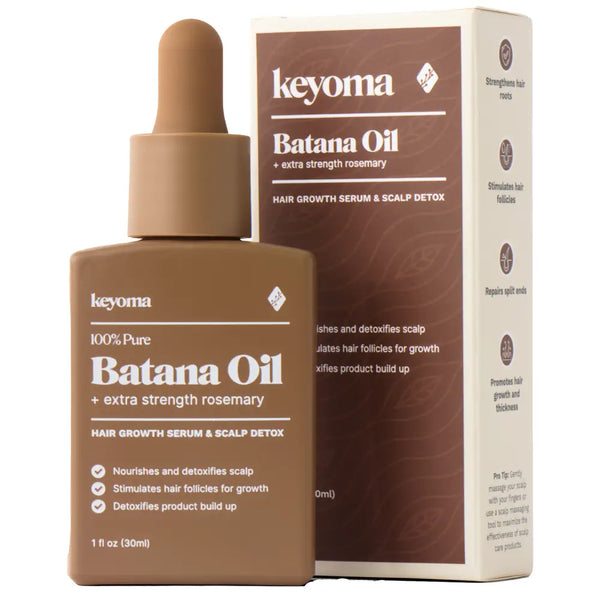
- 30-day supply $50
- 30% off for life $6
- Free haircare essentials kit $33
- Free custom wooden comb $10
- Free scalp massager $15
- Free eco-friendly travel bag $8
Your Cart
Your Cart is empty
Let's fix that
You might like...
Search our store


